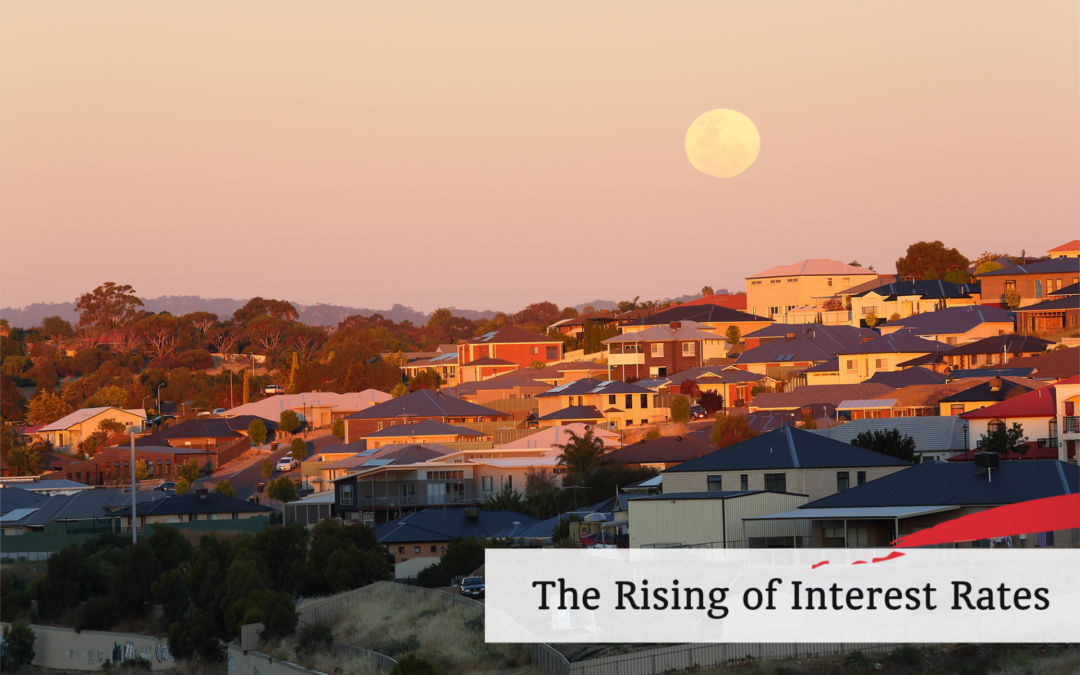
Just last month, Mortgage holders in Australia faced the unwelcome, but not completely unexpected news, that they will be paying more, with the central bank lifting the official cash interest rate for the first time since 2010.
We have included a summary of the recent announcement and what this means if you’re a mortgage holder. If you would like to discuss your personal situation, please don’t hesitate to contact our office at (08) 8172 9111.
After waiting over ten years for an interest rate rise, many of the 1 million borrowers who have never experienced an official interest rate rise could look to be paying an extra $1000 a month in mortgage repayments by the end of the year, if aggressive market forecasts for rate increases hold true.
The Reserve Bank of Australia insists home loan customers are well-placed to handle higher interest rates, with many ahead of their repayments by almost two years. However, a Commonwealth Bank economist warns that high household debt means borrowers will be extra-sensitive to rate rises and a doubling of fixed rates will cause consumers to trim spending.
Analysis by RateCity shows a 0.15 of a percentage point increase in the RBA cash rate to 0.25 per cent – tipped to occur in either May or June would add $47 in monthly repayments for a typical $600,000 owner-occupier mortgage and $78 a month for a $1 million home loan.
Following higher-than-expected annual inflation of 5.1 per cent reported recently, money markets are pricing in a cash rate of about 2.5per cent by the end of this year, implying rates would rise by at least 0.25 of a percentage point every month.
If that were to occur, it would add $779 to monthly repayments for a $600,000 loan and $1298 a month for a $1 million mortgage, according to RateCity’s director of research Sally Tindall. If the cash rate hits 3.4 per cent by mid-2023, as markets are betting, the monthly repayments could jump by $1100 and $1833 respectively compared to today, RateCity said.
Spending to be hit
Coles Chief Executive, Steve Cain said more people had jobs and more money than before the pandemic. But he said the combination of high debt and rising rates would reduce house prices and leave “people feeling less wealthy. We’ve got to be very sensitive to that.”
Goldman Sachs’ Economist, Andrew Boak said household consumption tended to remain resilient several years after the RBA started raising rates, with ongoing improvements in the labour market typically offsetting the headwind from higher mortgage payments.
“While household debt has increased since the 1990s, potentially making rate hikes more potent, net debt relative to income has actually fallen since the last two hiking episodes between 2006-08 and 2009-11,”
That is partly because of an extra $250 billion of household savings during the pandemic. About 60 per cent of home borrowers have variable rate loans.
Variable-rate borrowers are an average of about 21 months ahead on their loan repayments, up from 10 months at the start of the pandemic, according to the RBA’s financial stability review published in April. If interest rates rose by 2 percentage points, just over 40 per cent of these borrowers already typically make monthly payments that would be large enough to cover the increase. A further 20 per cent would face an increase in their repayments of no more than20 per cent, while about 25 per cent of variable-rate owner-occupiers would see their repayments increase by more than 30 per cent, the RBA has said.
However, the share of fixed-rate mortgage debt doubled to almost 40 per cent during the pandemic, as borrowers shifted into super-cheap fixed-rate loans of about 2 per cent. About $500 billion of fixed-rate mortgages are due to reset at higher rates over the next two years, with three in four fixed-rate borrowers facing refinancing by 2023.
So, what can borrowers do to ease mortgage pressure as interest rates climb?
Research what deals are around
The first thing borrowers can do is shop around to see which banks have the best interest rates on offer. Compare other lender offerings with your own mortgage and if you are not getting the best deal, take action.
New customers tend to get better deals than existing customers, so it could be time to look at refinancing your loan.
New loans are [on average] at 2.49% interest and existing customers are at 2.92% – that’s a difference of 0.43% which is almost two rate hikes so you can get yourself a buffer. The cheaper home loans will go up but you’re coming from a low base.
Check your spending
The next step is going through your own bills. You need to look at everything from your home and contents insurance, to health insurance, energy bills, your internet plan, subscriptions and gym memberships.
Ask yourself: ‘Do I want it? Do I need it? And am I on the best possible plan? Look for either the cheapest or the one that gets you the best value.
The chief executive of Financial Counselling Australia, Fiona Guthrie, says the other important thing to do is to see what concessions you might qualify for.
“For instance, you might be entitled to electricity concession,”
“State governments have good concession finder websites, where you put the information into the site and it shows you what you’re entitled to.”
Think about fixed rates
When announcing the decision to increase the cash rate from the record low 0.1%, the RBA signalled more rises to come, with Governor Philip Lowe saying it was “not unreasonable” to expect interest rates to rise to 2.5%. It could be helpful to take some time now to check if a fixed or variable rate is better for you. With fixed rates at 2% last year, many Australians already switched in the expectation that rates would rise.
A fixed-rate can offer certainty over two or three years, but there are pros and cons, so doing your research was important.

